![]()
![]()
![]()
Use LEFT and RIGHT arrow keys to navigate between flashcards;
Use UP and DOWN arrow keys to flip the card;
H to show hint;
A reads text to speech;
192 Cards in this Set
- Front
- Back
|
Are we born with a fully developed sensory and motor systems? |
No |
|
|
What do we rely on in the early stages of life |
Reflexive movements |
|
|
Do we have learned, voluntary movements when we are born? |
No
But we can produce some movements |
|
|
What are reflexes? |
Involuntary responses to external stimuli |
|
|
What are example of reflexes that babies perfom? |
Suckling reflex Rooting reflex Stepping reflex |
|
|
What is the rooting reflex of babies? |
If touch the baby's cheek, they will turn head towards the touch and open mouth |
|
|
What is the stepping reflex of babies |
If you hold the baby upright and their feet touch the ground, they will begin to make stepping motions |
|
|
Does the stepping reflex give rise to voluntary movements? |
Yes |
|
|
Which infant reflexes are related to survival? |
Suckling reflex and rooting reflex |
|
|
Do infant reflexes give rise to voluntary movements |
Yes |
|
|
Motor milestones occur after the disappearance of _______ |
Reflexes |
|
|
When do motor milestones occur? |
During the sensitive period |
|
|
What period is easier to develop particular skills given the appropriate stimuli |
Sensitive period |
|
|
What is a skill that is easier to develop during the sensitive period |
Learning a new language
Is easier to learn new language because the brain is more plastic (around the age of 4-6) |
|
|
What is the first child syndrome? |
The first born children tend to develop motor skills later than the second |
|
|
Why does the first child syndrome occur? |
Because parents are more likely to continuously hold the child |
|
|
Why can't humans walk immediately after birth? |
*Because of body proportion (head is giant in infants) *COM is higher in babies so much more difficult to balance *Have short limbs *High fat:muscle ratio; infants have a lot more fat and not fully developed muscles |
|
|
What is the different motor milestones in a graph |
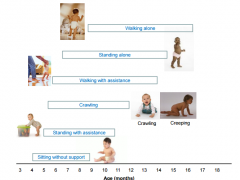
|
|
|
List out the different motor milestones |
*Sitting without support *Standing with assistance *Crawling *Walking with assistance *Standing alone *Walking alone |
|
|
What are the two stages of crawling |
*Stomach with contact to the ground *Creeping-What we identify with crawling on hands and feet |
|
|
Is there a wide range for each motor milestone |
Yes |
|
|
When do children have their first steps |
ARound 12 months |
|
|
What are characteristics of early walking? |
*Short steps *Little leg and hip extension *Flat footed landing (To keep bigger BOS) *Toes pointed out (Increased BOS) *Wide BOS *Little trunk rotation (Decreased movement of COM) *Arms in high guard position
|
|
|
Why do infants walk the way they do |
To help stability and keep their COM within the BOS |
|
|
What is the most common movement disorder in children |
Cerebral palsey |
|
|
What is the ratio of children with cerebral palsy |
~2.5/1000 children |
|
|
What could be the cause of cerebral palsy? |
Damage to or improper development of motor areas of the brain (all motor areas such as the basal ganglia)
Can start prenatal till around age 5 years
Leads to very small weak muscles because not able to accurately activate the muscles in the brain. therefore as muscles become smaller breathing decreases |
|
|
What can cerebral palsy affect |
motor skills coordination sensory feedback breathing |
|
|
Why could the family who walked on all four be a reason for? |
Environmental Genetic Proprioceptive
Could be damage to the cerebellum (The cerebellum may be damage from birth but can still walk upright |
|
|
What is the old view of reaching and grasping? |
Reaching is reflexive. |
|
|
What is the new view of reaching and grasping? |
Infants are capable of primitive hand eye coordination |
|
|
What is the visual acuity from birth to 10 years |
Visual acuity at birth: 20/800 1 year: 20/100 5 years 20:30 10 years 20/20 |
|
|
What do you need for depth perception? |
Complete vision of both eyes, visual field of left and right fields |
|
|
When does bioncular vision occur? |
14 months |
|
|
How do you test infants for depth perception |

|
|
|
Can you grasp at a young age and if so how and how does it change? |
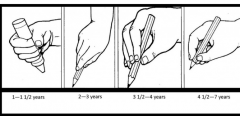
Early on it is a power grip but it's not till around 4 1/2 years old where you can develop a precision grip |
|
|
What are the three phases to the development of reaching? |
Pre-reaching Visually-guided reaching Visually elicited reaching |
|
|
When does pre-reaching occur? |
Birth-4 months |
|
|
When does visually guided reaching occur? |
4-8 months |
|
|
When does visually elicited reaching occur? |
9 months and older |
|
|
What phase of the development of reaching made researchers think that reaching was just reflexive for babies? |
Pre-reaching |
|
|
Is vision used to guide the hand in pre-reaching? |
No |
|
|
Are there corrections mid-course during pre-reaching? |
No |
|
|
Do you shape the hand to an object duirng pre-reaching |
No
Usually just use an open hand because need vision to correctly form the apperature |
|
|
Do you contact the target during pre-reaching? |
Rarely |
|
|
When infants in pre-reaching phase reach for something what is the outcome |
It is often incorrect and don't make any correction mid course |
|
|
Do visually guided reaching use vision to help guide reaching? |
Yes |
|
|
What do you do with the hand and the position of the object during visually guided reaching |
Comparision of hand position to the position of the object |
|
|
What are corrections like for visually guided reaching? |
There are several corrections mid-course |
|
|
How do you adapt reach to a distorted visual field during the visually guided reaching phase |
Yes |
|
|
How do infants with distorted visual field correct their movements compared to adults |
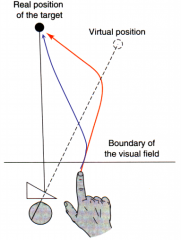
Infants make corrections much sooner and start making comparisons as soon as the hand is in the visual fields (adults have to wait till after their hand is much closer to the target to compare) because the infant still does not trust their motor skill.
Adults on the other hand reach out and wait till almost at the target and an use eyes with saccades and compare and make corrections to movements |
|
|
What infant phase of the development of reaching is most similar to adult reaching? |
Visually elicited reaching |
|
|
For the visually elicited reaching how much do you rely on vision |
You fully rely on vision |
|
|
What kind of corrections are made during the visually elicited reaching? |
Stop making continuous comparison between the position of the hand and target like how it was during visually guided reaching
They only make minor corrections |
|
|
What is the evidence that the visual information from the object is used for the visually elicited reaching? |
The baby is able to use vision to reach and will change their grasp based on the size fo the object |
|
|
Is auditory information consistently used by the infant during visually elicited reaching? |
The evidence is less consistent |
|
|
Are motor skills voluntary and involuntary |
Voluntary |
|
|
Are motor skills learned or innate |
Learned |
|
|
Are motor skills goal-oriented? |
Yes |
|
|
What is learning? |
A relatively permanent change in a person's ability to execute a motor skill as a result of practice or experience. |
|
|
What are the stages of learning? |
Cogntivie stage Associative stage Autonomous stage |
|
|
What is the cognitive stage of learning? |
Involves basic strategies
Increased error
Increased variable in performance |
|
|
What is a problem with the cognitive stage |
Degree of freedom problem
Lots of way to try and get to the optimal solution |
|
|
What is the associative stage of learning? |
When the subject start to recognize their error and understand what we did wrong to make that error and start with skill refinement |
|
|
What is the autonomous stage of learning? |
Movements become more automatic; don't have to think about steps to make the movement
Make more less error |
|
|
HM was a 27 year old man with severe epilepsy and he had surgical removal of the temporal lobes and hippocampus to prevent the seizures what was he able to do? |
Able to learn new motor skills |
|
|
HM was a 27 year old man with severe epilepsy and he had surgical removal of the temporal lobes and hippocampus to prevent the seizures what was he unable to do? |
Unable to recall event from day to day |
|
|
For HM how did he do for a star tracing in a mirror task over times |
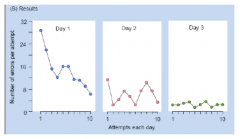
More trials makes less mistake and makes less errors over days which shows learning (learning new motor skills) |
|
|
What is declarative memory? |
Recollection of experiences and facts (IE what date is it today) |
|
|
What is non-declarative memory? |
Memory that is not expressed verbally such as procedural memory
This is knowing an entire procedure so it is not necessarily something that can be explained. |
|
|
What does HM's case suggest about the different forms of memory |
Memory is stored in different areas in the brain
The hippocampus is used for declarative memory and non-declarative memory is not stored in hippocampus or temporal lobe
The two memories are not stored in the same place |
|
|
How do we asses learning? |
By measure of performance (speed, accuracy, errors, etc) |
|
|
What is learning? |
Relatively permanent change in a person's ability to execute a motor skill |
|
|
What is the problems with assessing learning through performance |
There is a lot of varaiblity such as if sick or fatigued etc
Performance change also does not mean that the subject has learned, need follow up assessment to tell if learned |
|
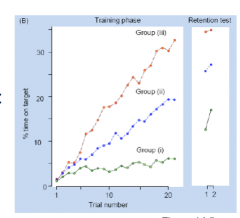
Is there learning involved? |
Even if a little bit lower on the secondary testing will be compared to the beginning and if better means has learned
In the graph all three have learned
If just looked at first day though, don't know if has learned |
|
|
Can you know if someone has learned just by looking at one day's information? |
No |
|
|
Does a learning curve generally have a steep or not steep initial portion |
Steep |
|
|
What are the pattern of learning curves |
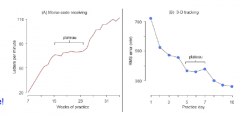
*Generally steep intial portion *Then slower improvements *Sometimes a plateau in the middle |
|
|
Why could there be a plateau in the middle of a learning curve |
It acts as a transition from one stage of learning to another
Maybe find another error that has to be correct or when the first start so bad that makes improvements very quickly and then start to find error difficulties
Start to regonize errors and work thorugh it maybe like associative phase |
|
|
Why is it incorrect to call something difficult that it has a "steep learning curve" |
If it is steep means that gaining improvement very quickly |
|
|
What is the difference between whole and part pratice? |
*Whole = Practice the entire task
*Part = practice componeents of the task seperately |
|
|
What is an example of whole practice in tennis |
Every practice just play |
|
|
What is an example of part practice in tennis |
Only practice a part such as just forehand |
|
|
Which is better whole or part practice? |
Depends on stages
In cognitive phase -> Cognitive is better because not really sure what you're doing
In associative and autonomous --> part works better |
|
|
What is the difference between blocked and random practice |
Blocked = practice different skills seperately
Random: Practice skills in a random order |
|
|
What is an example of blocked practice |
Just keep doing forehand and then switch to backhand. |
|
|
What is an example of random practice |
Just practice one skill at a time and may do forehand backhand, etc in random order |
|
|
Between blocked practie and random practice which one works better? |
Random practice works better at any stage because of contextual interference because by change it forces you to keep going through process |
|
|
What is the difference between massed and distributed (spaced) practice |
*Massed = long practice session but fewer of them OR fewer/shorter breaks
*Distributed = shorter practice sessions separated by longer breaks |
|
|
Does distributed or massed practice work better? |
Distributed
Rest helps with performance because it decreases fatigue |
|
|
What is the evidence that distributed pratice works better |
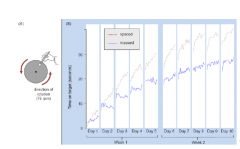
Subjects had to move a white dot around on a plate and have to track the dot as it moves around with a pencil
During the first day both distributed and massed practices saw improvement of performance but long term they saw a greater increase for the distributed trial |
|
|
What is the constraints-led approach for learning |
Constraints are presented to give the learner opportunity to overcome challenges
It is improtant to have information that is present in "game" settings for better learning of perception-action coupling |
|
|
Wat is the two types of feedback used to improve performance |
Internal feedback External feedback |
|
|
What is internal feedback |
Information from the body
(Ie in tennis wrist bent too much and get proprioceptive knowledge of that) |
|
|
What is external feedback |
Information from outside of the body (Information of where the ball actually lands) |
|
|
What is the two types of information can use for feedback |
Knowledge of performance Knowledge of results |
|
|
What is the knowledge of performance |
Focused on you, how you performed that movement (could come from either internal or external feedback) |
|
|
What is the knowledge of results |
Typically what we measure the results you see |
|
|
What is the test to know what feedback is helpful |
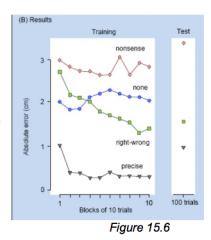
Blacks of trials of line drawing blindfolded. The goal is to draw a straight line 3 inches long
Did 10 blocks with 10 trial per block
Saw an improvement but also saw learning for right-wrong and precise feedback but saw that there was more help with the right-wrong |
|
|
Does correct feedback help |
Not really, yes-no feedback is better |
|
|
Is the frequency of feedback matter? |
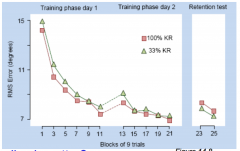
Not really, there was a test between giving feedback of 100% or 33% of trials and saw simialr data |
|
|
What is mental imagry? |
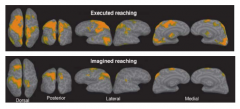
Mental or cognitive rehersal of a skill
Skill rehersal Arousal modification Active similar areas actual execution except for the visual area
Also activating the planning areas (primarily SMA) |
|
|
What is the evidence for imagry training |
Perform strength output of the ADM musce
they first tested strength (control) then do whatever as a contraction (strength training) and imaging training and then tested strength again
Control is same contraction has most increase in percentage and imaging has not as much but more than control |
|
|
What is the equation for actual practice, imagery and nothing |
Actual practice > imagry > nothing
|
|
|
Does imagery work better if combined with activual practice |
Yes |
|
|
What is the observational learning |
Watching another person perform a movement activates areas in the brain simialr to those activated when executing the movement
Visual cortex is highly activated, activation in planning and interpreation (but done in primary motor cortex) neurons activate in observed and executed movements through mirror neurons |
|
|
What is mirror neurons |
Neurons that are activated whether executed a movement OR watching someone else execute movement |
|
|
Waht is the apparent function in motor learning for mirror neurons? |
Understand the action Understand the intention Enable imitation |
|
|
Why do imagery and observation improve performance? |
Neurological changes, there is a coordination of differnet neurological pathways laying down neural pathways
Setting up expectation of proprioceptive response |
|
|
To establish procedural memory what three pathways are used |
Interpretation Strategy/plan Conceptualization |
|
|
Why is degrees of freedom a problem? |
Because there is an infinite number of solutions and need to figure out what is the optimized way to learn and relearn something |
|
|
What is a potential benefit of the degrees of freedom problem |
potential benefit following injury (redudancy) |
|
|
What can cerebellar damage lead to? |
*Overactivation of muscle in response to postural perturbations
*Difficulty with smooth pursuit of eye movement
*Standing balance is impaired
*Ability to track finger is compormised
*Eyes not in sync with leg movement
*Uncoordinated and less smooth movement
*Decreased stability during quiet stance
|
|
|
how many stroke per year |
~800,000 strokes per year |
|
|
What causes a stroke? |
Damage to brain cells which is due to lack of oxygen |
|
|
Most stroke is ischemic and some are hemorrhagic what does that mean? |
*Ischemic (blood clot in the blood vessel in brain so person does not get enough blood)
*Hemorrhagic is a fast and is when the blood vessel breaks and the face, arm, speech and time are in trouble) |
|
|
What do the symptoms of a stroke depend on |
Depend on location and extent |
|
|
What are some deficits of strokes |
Cognitive
Verbal (May have inability to speak or find the right words)
Motor (Such as spasticity, paralysis or loss of coordination)
|
|
|
Between all of the deficits of a stroke, what will everyone suffer from |
Motor because it is so easily affected so any sort of damge is sure to pose an issue |
|
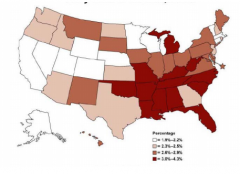
What does the map of stroke look similar to? |
Obesity |
|
|
What is the two phases of stroke recovery? |
Early recovery (~2 weeks) -Local processes
Later recovery |
|
|
What is early recovery of stroke rehabilition |
*Spontaneous *Resolution of edema *Reprofusion to get blood back *Recovery of potentially damaged neurons |
|
|
What is the later recovery of stroke rehabilition |
*Rehabilition *Modify structural and functionality of neurons and system (neuroplasticity) --> ability of the nervous system to change |
|
|
For stroke rehabilition, what is the percentage of patients who have complete spontaneous recovery? |
~10% of patients fully recover |
|
|
What percentage of patients have no benefit from rehab during stroke rehabilition |
~10% |
|
|
What percentage of patients have benefit from rehab? |
~80% of patients |
|
|
What is a common syptom of stroke? |
Hemiparesis |
|
|
What is hemiparesis? |
Weakness on one side of the body
(It is not fully paralyzed, is a form of substantial weakness and the subject needs to engage that limb) |
|
|
What contributes to learned paralysis |
Hemiparesis
Because the area is not getting as many signals and movements so the body parts compete for "real estate" in the brain and may take up the space the body area had before
(IE if stop using the right hand, brain says, we are not using this and will reorganzie to take up that area which leads to learned paralysis) |
|
|
When we are retraining the brain for stroke patients what are we doing? |
Finding a new optimal solution |
|
|
What are physical rehabilition stroke patients can do for hemiparesis |
*Physical movements (Either active or inactive movement) *Mental imagery *Electrical stimulation (Stimulate and activate muscle) *Constraint-induced therapy *Mirror training |
|
|
What can mental imagery help with? |
Increasing strength (Because activate the SMA and establish a plan and procedurla memory)
Help to re-learn activities of daily living (Helps to improve activites of dialy living) |
|
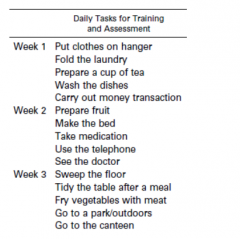
How were they able to test the re-learn activities of daily living through mental imagery? |
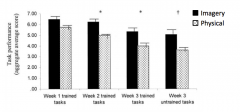
Had them think about or complete the different tasks each week then after three weeks, they tested their performance on the test and saw that there was a higher performance on activities after imagery training than physical rehabilitation. |
|
|
Why were people able to have a higher performance on activities of daily living after imagery training than physical rehabilitation? |
Imagery helps with strength as well as function. While phsyical rehabilition still make errors but you are always doing it right in your mind. |
|
|
What is functional electrical stimulation? |
*Use of electrical muscle stimulation to produce functional movements for stroke rehabilitation. This way can activate muscle and make sure there is no muscle atrophy
This also helps to generate peripheral feedback to help to create better connections
But this only works for some people but when it does, it works for a long time |
|
|
How do the FES differ from TENS? |
TENS does not produce functional movement but FES does |
|
|
If learned paralysis has occured, would FES work? |
Not really would have limitations |
|
|
What is constraint-induced movement therapy? |
Constrain unaffected limb to encourage use of affected limb it first starts in therapy session then move into daily life |
|
|
What is mirror training? |
"Tricking" the brain through visual feedback |
|
|
Why does mirrror training work? |
Because we believe our visual system over our motor system |
|
|
What causes pain in phantom limb |
Nerve cells that are damaged or cut and into the brain |
|
|
Is the dominant hand or non-dominant hand better at gross and fine movements? How about for ambidextrous people |
Dominant hand better at fine movement
Non-dominant hand better at gross movement
While for ambidextrous people have better coordenated signals |
|
|
If there is a 70 year old male, 2 weeks post-stroke with hemiparesis of left hand an arm. Outline a rehabilitation program to improve reachign function, including the technqiues you would use, the practice scheduel and the assessment of "learning" |
*Have him perform more strength training (because atrophy could be an issue) then would decrease the learned paralysis. Over time have them have more observational and mental imagery. Depending on paralysis but would want both
Then woudl want whole practice because probably back at the cognitive stage and whole practice works better with random training that is blocked. (Also distributed might be perferable because fatigue is an issue)
*Could also do specitic activity (IE draw a stragiht line) and have constraint-induced movement therapy for activities of daily living |
|
|
What is affected in peripheral neuropathy? |
Damage to peripheral nerve (can also involve some of the neurons of the CNS but not the brain)
But mainly the alpha motor neuron or sensory nerves |
|
|
What happens to the peripheral nerves in peripheral neuropathy |
Loss of action potential transmission |
|
|
How much of the population does peripheral neuropathy affect? |
~2% of the total population
~8% of individuals over 55 years and ~26% of diabetics |
|
|
What are the causes of peripehral neuropathy? |
*Disease (ALS, diabetes)
*Inflammation
*Trauma |
|
|
What sense is most affected by peripheral neuopathy? |
Proprioception |
|
|
Is there more or less occurance of peripheral neuropathy if someone gets older? |
More |
|
|
What is amyotrophic lateral sclerosis also called? |
ALS Motor neuron disease Lou Gehrig's disease |
|
|
How many americans does ALS affect? |
~30,000 americans |
|
|
What causes amyotrophic lateral sclerosis? |
Degeneration of motor neurons (Sensory is also affected but motor is priamrily affected)
Both the alpha and cortical spinal neurons |
|
|
What are the symptoms of ALS? |
*Weakness *Muscle atrophy *Muscle stiffnes
Weakness and msucle atrophy are unexplained
But for muscle stiffness when damage occurs in nerves the nerves fires irregular patterns so there is muscle stiffness and muscle activate to decrease the level |
|
|
What are the causes of ALS? |
~10% genetic
~90% are unknonw (don't know exactly why the nerve start to degrade) T |
|
|
There is increased membrane excitability in ALS explain that. |
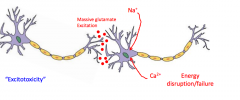
The motor neurons become hyperexcitable at the synapse and more neurotransmitters send a massive amoutn of glutamate out which is an excitatory NT and so there is a massive influence of sodium to generate an increased amount of action potentials because glutamate are just consistant and all sodium means calcuium channel stuck open so there's also an increase in calcium
This costs energy and causes a disruption of energy in the cell which causes it to start to fail. There is also an increase in byproducts and get oxidative stress which produces an immune response and will start to decay the myelin sheath of the axon of the neuron
This can also lead to involuntary activation of muscle |
|
|
Can you do mirror for the increased membrane excitability of ALS? |
No, because the problem isn't in the brain (rewiring the brain won't help) |
|
|
What would you focus on training for ALS? |
Would focus on training the muscle and help to slow down the muscle degeneration and also use immunosuppression to prevent degeneration |
|
|
What is the survival post diagnosis of ALS? |
50% |
|
|
What is the survival 10 years post diagnosis? |
10%j |
|
|
Is there a cure for ALS? |
No |
|
|
Is cognitive function fine in patients with ALS? |
Yes, but complications with muscle in speech or writing |
|
|
What is the best form of treatment for ALS? |
Pharmacudecal treatmetn through Rilozole to reduce glutamate and Ca++
If you decrease the amount of glutamate will also decrease calcium uptake but this will be for the hwole body not jut the neurons |
|
|
Is parkinson's disease more prevalent on the west or east coast? |
East |
|
|
How many people have parkinsons' |
7-10 millon worldwide 1 million in USA |
|
|
Does Parkinson's incidence increase or decrease with age? |
Increase |
|
|
Parkinson's is ____ times more likely in men than woman |
1.5
Don't quite know why |
|
|
Parkinsons is idiopathic, what does that mean? |
The cause is unknown
Genetic? Pesticide exposure? Head injury? |
|
|
Parkinsons is an accumulation of waht? |
Lewy bodies which are proteins witin the neurons
|
|
|
What do the accumulation of lewy bodies cause in the brain? |
Cause cell dysfunction and/or death because the protein interfere with the signal of neurons and lead to death
They lead to the death of dopamine-producing neurons in the substantia nigra |
|
|
Substantia nigra is for what? |
Movement initiation |
|
|
Does the substantia nigra influence several motor areas? |
Yes |
|
|
How does the substantia nigra influence multiple motor areas? |
Through the basal ganglia
therefore they may have issue with producing but also stopping movements so these patterns may contradict each other |
|
|
What are the parkisnon's disease symptoms? |
*Tremor (shaking) *Rigidity (stiffness) - The background activity keeps the muscle more tonically active *Bradykinesia (slowness of movement( *Movement initiation difficulty *Postural instability - All of the previous symptoms can lead to postural instability |
|
|
Is there a cure for parkinson's disease? |
No |
|
|
How do we improve the motor symptoms of parkinson's disease? |
*Depends on the symptom
*Trick brain *L-dopa *DBS |
|
|
How do you trick the brain in parkinson's disease? |
Rewire to get around the problem of the damage but dpends on the symtpom and let self forward and make self have to take a step as a relfex
Can also have lasers attached to the walker which allows for a visual cue (pre-motor) to stat walking by sending through a different pathway to go past the damged area and use a different pathway instead |
|
|
What is the pharmacological treatment of Parkinson's Disease |
L-dopa
Which blocks the reuptake of dopamine and also develop sensitivity
So need to increase the doses in time in order to treat both the symptoms of turning off and turning n the symptoms but mainly used for the the lack of inhbiition |
|
|
What is the surgical treatment for parkinson's disease |
Deep brain stimulation
Becoming more common (in later stages) you implant electrodes into the basal ganglia so help with both stopping motor and also issue of inhibition of them movement |
|
|
What causes multiple sclerosis? |
Demylenation of CNS in the brain and spinal cord |
|
|
When was MS first diagnosed? |
In 1849 |
|
|
Approximately how many people are affected with MS? |
400,000 |
|
|
What is the average onset age of MS |
37 (onset is generally before the age of 40) |
|
|
Who is more likely to have MS men or women? |
Women are 3 times more likely but don't really know why |
|
|
What are the causes of MS? |
Auto-immune (Simialr to the endotoxic cascade talked about before where there is something wrog and the immune system starts to attack and degrade the healthy neurons but don't know exactly what that means)
Genetic
Infectious
Environmental |
|
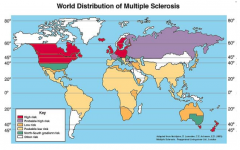
Why does the map for MS prevalence look like this? |
US and Canda have most because of environmental fctor
While those with most sun have lower, might be linked to vitamin D? |
|
|
What are the symptoms of MS? |
*Slowed and irregular conduction velocity *High levels of fatigue *Numbness *Pain *Loss of coordination *spasticity *Tremor |
|
|
Explain the classifications of MS |
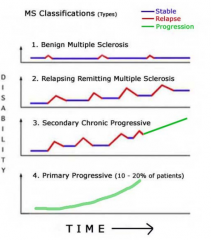
1) benignMS - Pretty stable then have a bout but get better
2) Relapsing remitting multiple sclerosis (most common) - Simialr to benign but with each relapse get worse and this often progresses to secondary chronic progressive
3) Secondary chronic progressive-just keep progressing afterwards
4) Primary progressive? (Least common) - no remission, symptoms just keep getting worse and worse |
|
|
Is there a known cure for multiple sclerosis? |
No |
|
|
What are some treatment of MS |
*Pharmacological treatment of inflammation (help with pain and decrease the impact on immune)
*Physical rehabilitation (can be difficult because of fatigue especially in relapsing phase)
*DBS
*Opening veins that carry blood away from the head but this is controversial and involves the chronic cerbrospinal venous insufficiency)-Cause by lack of oxygen to brain so can't carry away the byproduct and the idea of the srugery is to open up the vein to allow go through |
|
|
For the 86 year old man who drove his car through the market, what could have gone wrong if the man was a stroke survivor? |
*could have muscle spasm and stepped on gas instead
*Loss of peripheral sensation
*hemiparesis |
|
|
For the 86 year old man who drove his car through the market, what could have gone wrong if the man had Parkinsons |
*Tonic pressure on gas because tremor or spasticity
*couldn't initiate movement from gas to brake |
|
|
For the 86 year old man who drove his car through the market, what could have gone wrong if he had peripheral neuropathy |
*Couldn't get signal from brain to muscle *Problem with sensation of pressure or which pedal he was on |

